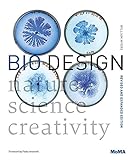Bio design : nature, science, creativity / William Myers ; foreword by Paola Antonelli.
Tipo de material: TextoIdioma: Inglés Editor: London : Thames and Hudson, 2018, c2021Edición: Revised and expanded editionDescripción: 304 páginas : ilustraciones ; 21 cmTipo de contenido:
TextoIdioma: Inglés Editor: London : Thames and Hudson, 2018, c2021Edición: Revised and expanded editionDescripción: 304 páginas : ilustraciones ; 21 cmTipo de contenido: - texto
- sin mediación
- volumen
- 9781633450714
- 741.6 M996b 2021
| Tipo de ítem | Biblioteca actual | Colección | Signatura topográfica | Estado | Fecha de vencimiento | Código de barras | Reserva de ítems | |
|---|---|---|---|---|---|---|---|---|
| Libro | Biblioteca Central | Colección General | 741.6 M996b 2021 (Navegar estantería(Abre debajo)) | Disponible | 33409003162884 |
Navegando Biblioteca Central estanterías, Colección: Colección General Cerrar el navegador de estanterías (Oculta el navegador de estanterías)

|

|

|

|

|

|

|
||
| 741.6 M978g 1997 Graphics : real-world graphic design projects- from brief to finished solution / | 741.6 M987 1996 Music graphics. | 741.6 M996b 2012 Bio design : nature, science, creativity / | 741.6 M996b 2021 Bio design : nature, science, creativity / | 741.6 N147L 2007 Logo mondo / | 741.6 N161 2009 Naive : modernism and folklore in contemporary graphic design / | 741.6 N438 2013 Neon : new fluorescent graphics / |
´With 467 illustrations, 436 color´ --Title page.
Originally published: New York: The Museum of Modern Art, 2012.
Incluye bibliografía.
Vital design -- Hybrid frontier -- Beyond mimicry -- Architectural hybrid : living structures and new ecological integrations -- Ecological object engineering : replacing industrial and mechanical processes -- Experimental functions : speculative objects, teaching tools and provocations -- Dynamic beauty : artwork crawling off the auction block -- Profiling programs and collaborations : consilience in the 21st century -- Interviews : David Benjamin, Ginger Krieg Doiser, Sean Quinn, Jessica Green, Dan Grushkin, Marin Sawa, Eduardo Kac, Oron Catts, Maria Aiolova.
´Bio design´ examines some seventy projects (concepts, prototypes and completed designs) that cover the fields of architecture, industrial processes, education, fine art, material engineering and bioengineering. Each project is illustrated by a short text, images and captions that combine to explain the problems the venture tackles, and how living materials and processes were harnessed to solve them in sustainable and aesthetically pleasing ways. Designers and artists have always looked to nature for inspiration and materials, but only recently have they been able to alter and incorporate living organisms in their work. In a world with finite resources and a growing population, design that mimics or appropriates the sustainable template of nature is likely to prove as vital as it is novel. Many of the solutions also provoke thought about manipulating life for human ends. From bacteria that can spin microfibrils of pure cellulose for use in the clothing industry to pigeons that fed special bacteria excrete harmless detergent instead of faeces, and from lamps that require blood to function to genetically hacked plants with human DNA biological design ... science future is here and now.
No hay comentarios en este titulo.
